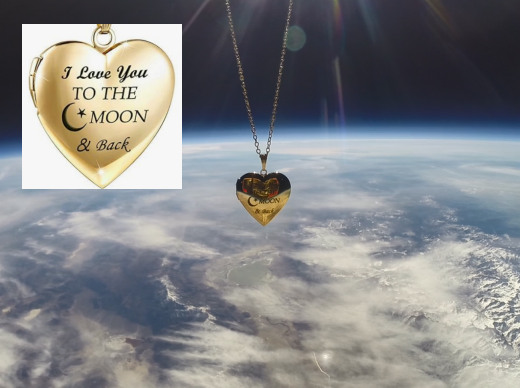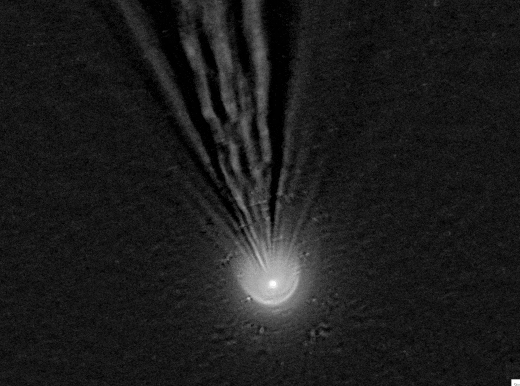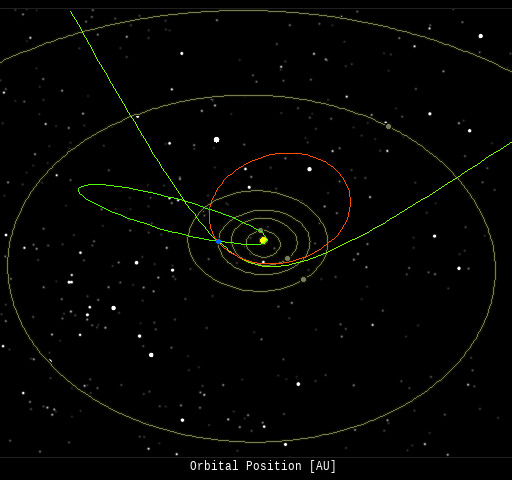This is an AI Free Zone! Text created by ChatGPT and other Large Language Models is spreading rapidly across the Internet. It's well-written, artificial, frequently inaccurate. If you find a mistake on Spaceweather.com, rest assured it was made by a real human being. | | |
A GEOMAGNETIC STORM IS UNDERWAY: The big CME hasn't reached Earth, but a geomagnetic storm is already underway. Equinox cracks in Earth's magnetic field have allowed solar wind to penetrate, igniting G1 to G2-class storms on March 23rd. Aurora alerts: SMS Text.
A BIG CME IS COMING: This morning's X1-class solar flare hurled a bright CME toward Earth. NASA and NOAA models agree that the storm cloud should reach our planet by the early hours of March 25th. A direct hit could spark strong G3-class geomagnetic storms with mid-latitude auroras in the USA and Europe.

SOHO coronagraphs captured this halo CME heading for Earth on March 23, 2024
Would you like a text message when the CME arrives? Sign up for our Space Weather Alert Service to receive instant notifications of CME impacts. CME alerts: SMS Text.
Realtime Space Weather Photo Gallery
Free: Spaceweather.com Newsletter
STRONG X-CLASS SOLAR FLARE: The sun just produced a solar flare so strong, it took two sunspots to make it. Improbably, sunspots AR3614 and 3615 exploded in tandem on March 23rd around 0130 UT, directing their fire straight at Earth. A National Solar Observatory telescope in Australia recorded the double blast:

The explosion from AR3614 (top) seemed to rip the fabric of the sun, while AR3615 (bottom) followed close behind with a less violent blast of its own. The same sequence was captured in this movie from NASA's Solar Dyanamics Observatory.
While this may seem like an incredible coincidence, it probably didn't happen by chance. Researchers have long known that widely-spaced sunspots can explode in tandem. They're called "sympathetic solar flares." Occasionally, magnetic loops in the sun's corona fasten themselves to distant pairs of sunspots, allowing explosive instabilities to travel from one to the other. This has apparently happened to AR3614 and AR3615.
Some sympathetic flares are so much alike, they are considered to be twins. Today's double-blast was not a perfect twin, but close enough. It shows that the two sunspots are linked, raising the possibility of more double-flares this weekend. Solar flare alerts: SMS Text.
Realtime Space Weather Photo Gallery
Free: Spaceweather.com Newsletter
18K GOLD "LOVE YOU TO THE MOON" LOCKET: This is a very special locket. It's heart-shaped, plated with 18K gold, and we will fly it again during this year's total eclipse of the sun. Keep reading...
On Jan. 26, 2024, the students of Earth to Sky Calculus launched this locket to the stratosphere onboard a cosmic ray research balloon. At the apex of the flight, it floated 111,535 feet above the Sierra Nevada mountains of central California:

Buy it now for $149.95, and we'll fly it again--FOR FREE--during the total solar eclipse on April 8, 2024. The students will be launching multiple balloons from the path of totality in Texas. Your pendant will go along for the ride, touching the shadow of the Moon at the edge of space. (Simply type "FLY IT AGAIN" in the comments box at checkout.)
The locket, which opens to hold a personal photo or other small item, comes with a greeting card showing the jewelry in flight and telling the story of its journey to the edge of space.
Far Out Gifts: Earth to Sky Store
All sales support hands-on STEM education
SPIRALING COMET: Shapeshifting Comet 12P/Pons-Brooks has been a devil, ,a Romulan Warbird, a Millennium Falcon--and now it's a lawn sprinkler. Michael Jaeger photographed the comet's spiralling core from his backyard observatory in Martinsberg, Austria:

Jaeger assembled this movie from a series of pictures he took during the first week of March. Researchers believe that an "ice geyser" on the comet's surface erupted Feb 29th, spewing a reflective plume of space-cold gas and dust into comet's atmosphere. Jaeger's animation shows that plume bent into a spiral shape by the spin of the comet's core.
Comet 12P is currently located in the constellation Pisces, about 15 degrees above the western horizon after sunset for most observers in the northern hemisphere. Shining as brightly as a 5th magnitude star, it is a relatively easy target for backyard telescopes. Point your optics here and take a look!
Realtime Comet Photo Gallery
Free: Spaceweather.com Newsletter
Realtime Aurora Photo Gallery
Free: Spaceweather.com Newsletter
Every night, a network of
NASA all-sky cameras scans the skies above the United States for meteoritic fireballs. Automated software maintained by NASA's Meteoroid Environment Office calculates their orbits, velocity, penetration depth in Earth's atmosphere and many other characteristics. Daily results are presented here on Spaceweather.com.
On Mar 22, 2024, the network reported 3 fireballs.
(3 sporadics)

In this diagram of the inner solar system, all of the fireball orbits intersect at a single point--Earth. The orbits are color-coded by velocity, from slow (red) to fast (blue). [Larger image] [movies]
Potentially Hazardous Asteroids (
PHAs) are space rocks larger than approximately 100m that can come closer to Earth than 0.05 AU. None of the known PHAs is on a collision course with our planet, although astronomers are finding
new ones all the time.
On March 23, 2024 there were 2349 potentially hazardous asteroids.
 |
Recent & Upcoming Earth-asteroid encounters: | Asteroid | Date(UT) | Miss Distance | Velocity (km/s) | Diameter (m) |
| 2024 ED3 | 2024-Mar-18 | 3.5 LD | 9.9 | 31 |
| 2024 EN3 | 2024-Mar-18 | 5.6 LD | 6.4 | 16 |
| 2024 EN | 2024-Mar-18 | 3.9 LD | 12 | 46 |
| 2020 FD | 2024-Mar-18 | 4.5 LD | 15.1 | 10 |
| 2024 BD7 | 2024-Mar-19 | 18.8 LD | 10.1 | 140 |
| 2024 FY1 | 2024-Mar-19 | 2 LD | 10.3 | 19 |
| 2024 FO1 | 2024-Mar-20 | 6 LD | 14.8 | 17 |
| 2024 EQ3 | 2024-Mar-20 | 12 LD | 10.8 | 14 |
| 2024 EZ3 | 2024-Mar-20 | 11.6 LD | 5.8 | 25 |
| 2024 EY3 | 2024-Mar-20 | 12 LD | 11.6 | 44 |
| 2024 FD1 | 2024-Mar-20 | 2.9 LD | 5.1 | 5 |
| 2024 FK1 | 2024-Mar-22 | 2.7 LD | 7.5 | 21 |
| 2024 EU4 | 2024-Mar-23 | 18.9 LD | 28.3 | 134 |
| 2024 EL4 | 2024-Mar-23 | 14.7 LD | 11.8 | 39 |
| 2024 EC4 | 2024-Mar-24 | 19.5 LD | 4 | 26 |
| 2019 CJ | 2024-Mar-24 | 12.4 LD | 4.4 | 28 |
| 2021 CF6 | 2024-Mar-25 | 14.6 LD | 8.3 | 62 |
| 2024 EA3 | 2024-Mar-27 | 8.2 LD | 10.8 | 47 |
| 2024 EO4 | 2024-Mar-27 | 13.1 LD | 14.9 | 40 |
| 2024 EO3 | 2024-Mar-28 | 10.1 LD | 11.4 | 40 |
| 2024 FN1 | 2024-Mar-28 | 16 LD | 6.6 | 21 |
| 2024 ES4 | 2024-Mar-28 | 17.8 LD | 5.1 | 25 |
| 2024 FB1 | 2024-Mar-29 | 7.6 LD | 13.2 | 31 |
| 2024 FK | 2024-Mar-29 | 3.1 LD | 19.2 | 30 |
| 2024 ED4 | 2024-Mar-29 | 14.5 LD | 7.8 | 19 |
| 2023 RO49 | 2024-Mar-29 | 14.1 LD | 4.3 | 45 |
| 2015 MB54 | 2024-Mar-30 | 11.7 LD | 3.8 | 54 |
| 2024 DQ | 2024-Mar-30 | 6.4 LD | 2.9 | 41 |
| 2018 CC14 | 2024-Apr-03 | 19.6 LD | 8.9 | 115 |
| 2023 GC2 | 2024-Apr-04 | 8.7 LD | 5.7 | 12 |
| 2024 FG | 2024-Apr-07 | 12.4 LD | 9.8 | 53 |
| 2024 FH2 | 2024-Apr-07 | 16.2 LD | 19.8 | 127 |
| 2005 FG | 2024-Apr-08 | 18.4 LD | 5.5 | 57 |
| 2020 BP13 | 2024-Apr-09 | 15.2 LD | 6.8 | 209 |
| 2021 RJ19 | 2024-Apr-12 | 19.6 LD | 11.4 | 25 |
| 2021 GQ5 | 2024-Apr-13 | 8.8 LD | 7.5 | 7 |
| 2023 FN13 | 2024-Apr-14 | 3.3 LD | 4.9 | 13 |
| 2022 UO1 | 2024-Apr-14 | 16.7 LD | 14 | 33 |
| 517681 | 2024-Apr-15 | 18.4 LD | 14.2 | 589 |
| 439437 | 2024-Apr-15 | 8.5 LD | 16.5 | 609 |
| 2023 HU3 | 2024-Apr-18 | 15.9 LD | 19.1 | 35 |
| 2021 JW2 | 2024-Apr-19 | 1.6 LD | 5.1 | 11 |
| 2017 SA20 | 2024-Apr-19 | 3.8 LD | 6.2 | 8 |
| 2021 VH2 | 2024-Apr-25 | 9.3 LD | 2.7 | 6 |
| 2021 GD3 | 2024-Apr-30 | 11.4 LD | 3.5 | 14 |
| 2022 TN1 | 2024-Apr-30 | 18.6 LD | 17.7 | 295 |
| 2022 AA5 | 2024-May-02 | 12 LD | 8.9 | 67 |
| 2021 JG9 | 2024-May-10 | 16.9 LD | 16.1 | 32 |
| 2016 FT14 | 2024-May-10 | 19.9 LD | 5.9 | 39 |
| 2015 KJ19 | 2024-May-14 | 15.8 LD | 23.1 | 112 |
| 2014 WF6 | 2024-May-14 | 7.2 LD | 18.9 | 47 |
| 2021 JN10 | 2024-May-14 | 17.5 LD | 13.2 | 33 |
| 2021 JJ | 2024-May-15 | 17.2 LD | 5.8 | 28 |
| 2022 WN2 | 2024-May-17 | 13.7 LD | 5.5 | 6 |
| 2019 VB5 | 2024-May-21 | 7.8 LD | 6.3 | 2 |
Notes: LD means "Lunar Distance." 1 LD = 384,401 km, the distance between Earth and the Moon. 1 LD also equals 0.00256 AU. | | Cosmic Rays in the Atmosphere |
SPACE WEATHER BALLOON DATA: Almost once a week, Spaceweather.com and the students of Earth to Sky Calculus fly space weather balloons to the stratosphere over California. These balloons are equipped with sensors that detect secondary cosmic rays, a form of radiation from space that can penetrate all the way down to Earth's surface. Our monitoring program has been underway without interruption for 7 years, resulting in a unique dataset of in situ atmospheric measurements.
Latest results (July 2022): Atmospheric radiation is decreasing in 2022. Our latest measurements in July 2022 registered a 6-year low:

What's going on? Ironically, the radiation drop is caused by increasing solar activity. Solar Cycle 25 has roared to life faster than forecasters expected. The sun's strengthening and increasingly tangled magnetic field repels cosmic rays from deep space. In addition, solar coronal mass ejections (CMEs) sweep aside cosmic rays, causing sharp reductions called "Forbush Decreases." The two effects blend together to bring daily radiation levels down.
.Who cares? Cosmic rays are a surprisingly "down to Earth" form of space weather. They can alter the chemistry of the atmosphere, trigger lightning, and penetrate commercial airplanes. According to a study from the Harvard T.H. Chan school of public health, crews of aircraft have higher rates of cancer than the general population. The researchers listed cosmic rays, irregular sleep habits, and chemical contaminants as leading risk factors. A number of controversial studies (#1, #2, #3, #4) go even further, linking cosmic rays with cardiac arrhythmias and sudden cardiac death.
Technical notes: The radiation sensors onboard our helium balloons detect X-rays and gamma-rays in the energy range 10 keV to 20 MeV. These energies span the range of medical X-ray machines and airport security scanners.
Data points in the graph labeled "Stratospheric Radiation" correspond to the peak of the Regener-Pfotzer maximum, which lies about 67,000 feet above central California. When cosmic rays crash into Earth's atmosphere, they produce a spray of secondary particles that is most intense at the entrance to the stratosphere. Physicists Eric Regener and Georg Pfotzer discovered the maximum using balloons in the 1930s and it is what we are measuring today.
| | The official U.S. government space weather bureau |
| | The first place to look for information about sundogs, pillars, rainbows and related phenomena. |
| | Researchers call it a "Hubble for the sun." SDO is the most advanced solar observatory ever. |
| | 3D views of the sun from NASA's Solar and Terrestrial Relations Observatory |
| | Realtime and archival images of the Sun from SOHO. |
| | information about sunspots based on the latest NOAA/USAF Active Region Summary |
| | current counts of failed and deployed Starlink satellites from Jonathan's Space Page |
| | Authoritative predictions of space junk and satellite re-entries |
| | from the NOAA Space Environment Center |
| | fun to read, but should be taken with a grain of salt! Forecasts looking ahead more than a few days are often wrong. |
| | from the NOAA Space Environment Center |
| | the underlying science of space weather |
 | When looking for casinos to play online when the weather is bad, you can try the SkyCity Online Casino if you are located in New Zealand. If you are not from NZ you can try the Swedish page Svenska casino online to find suitable games, check out svenskacasinoonline.net. Always check your local laws before playing with real money.. |
 | BestCSGOGambling is the best site for everything related to CSGO gambling on the web |
| | These links help Spaceweather.com stay online. Thank you to our supporters! |
| | | | | | |

